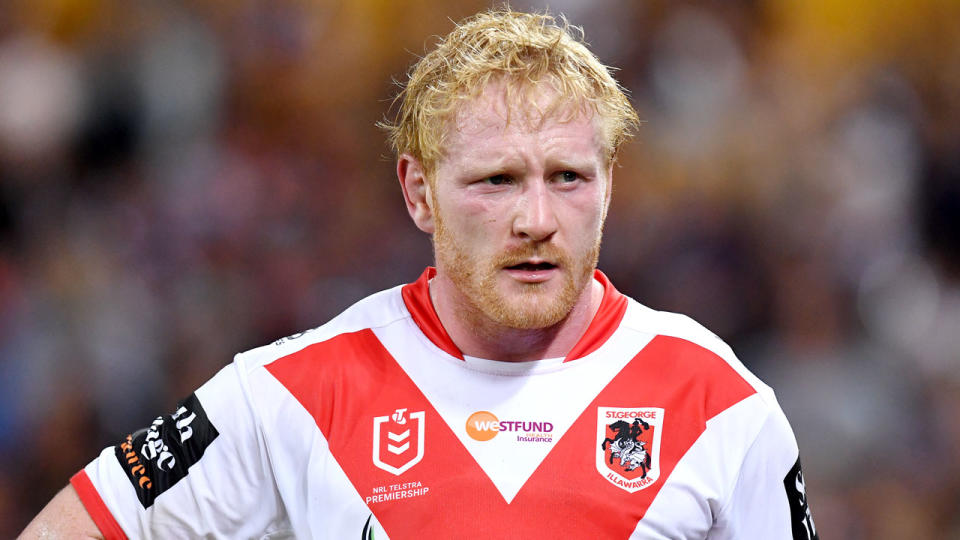Why this NRL star will donate his brain to science after death
St George Illawarra veteran James Graham has revealed he will donate his brain to science when he dies.
The news comes in the same week the significant discovery of Chronic Traumatic Encephalopathy in two former NRL players was made.
The Englishman is set to follow in the footsteps of retired greats Peter Sterling and Mark Carroll in helping scientists discover more about the effects of repeated head knocks on the brain.
More than 80 athletes have already pledged to donate their brains to the Australian Sports Brain Bank set up by Associate Professor Buckland in 2018.
Graham, who sparked a back-and-forth with media identity Peter FitzSimons over concussions earlier this year, finalised his plans this week.
“I sent my papers off on Wednesday (to donate my brain) so I guess when I die my brain and spinal cord, if I’m in Sydney, will be going to the Sydney University for them to look at, examine and hopefully some good can come of this,” he told Fox Sports.
“It’s great to see people like Peter Sterling donating his brain and I think the more players of all codes can sign up, it can only lead to more research being done and figuring out the answers of what is a very tricky and complex situation..
“Now that it’s out there, now that it’s confirmed they’ve found CTE in some former NRL players, it brings the talk about concussion back to the table.
“I’m really pleased to see the game is taking it seriously and I’m really interested to see the next step we take as a game.”
Former Manly rugby union player Barry "Tizza" Taylor is the only other case of CTE identified in Australian sport.

What is CTE?
CTE is a degenerative brain disease found in former players of American football, ice hockey, soccer, rugby union and others exposed to repeated head injury.
The disease, originally called punch-drunk syndrome to describe the plight of ex-boxers, often leads to depression and other behavioural disturbances in younger people.
Symptoms in older people, however, may be indistinguishable from Alzheimer's disease. It can only be diagnosed confidently by examination of the brain after death.
The only known risk factor for CTE is repeated concussions and blows that don't cause signs or symptoms.
What was the discovery?
Researchers and clinicians from Royal Prince Alfred Hospital, NSW Health and the University of Sydney's Brain and Mind Centre found signs of CTE in two donated brains from middle-aged former professionals who played more than 150 NRL games over many years.
Their identities have been kept confidential.
Lead author Associate Professor Michael Buckland said the changes in the two brains were "distinctive and definitive".
"I have looked at about 1000 brains over the last 10 years and have not seen this sort of pathology in any other case before," he said in a statement on Thursday.
"The fact we have now seen these changes in former rugby league players indicates they, and likely other Australian collision sports players, are not immune to CTE, a disease that has gained such high profile in the United States."
The head of the Concussion Legacy Foundation in Boston labelled the Australian research - published in the international journal Acta Neuropathologica Communications on Thursday - a "groundbreaking" discovery.
"We hope the first proof of CTE in rugby league inspires the Australian scientific community to mobilise in the fight against CTE and advances the conversation on reforms to sport that can prevent this disease," Dr Christopher Nowinski said.
It's estimated there is one concussion every 3.35 games of professional rugby league - but that rate may be significantly higher in youth competitions, the study noted.
"Given that brain autopsy is rarely pursued these days, even in cases of suicide referred to the coroner, it is difficult to assess whether these two CTE cases are serendipitous findings or emblematic of a more common issue with rugby league and other Australian football codes," the paper said.
What was the NRL’s response?
The NRL says it will review the study's findings before making any detailed comment but notes its approach to management of head injuries is based on global best-practice.
"The NRL has significantly increased its focus and investment in this area of player safety and will continue as an active participant in the work of the global sport community to advance the understanding and management of head injuries in contact sport," a spokesman said on Thursday.
The Rugby League Players Association said the game in Australia had led the way with a raft of initiatives in recent years.
"While this particular study relates to rugby league, it's important to note that this is an issue across a range of sporting codes and that we will continue to promote collaborating and further investment in this area to ensure athletes are informed and protected at all levels," an RLPA spokesman said.
with AAP
